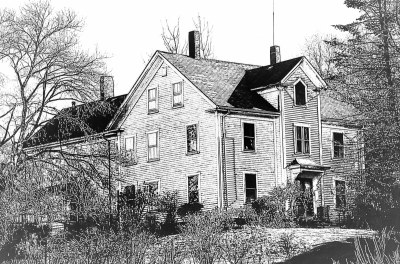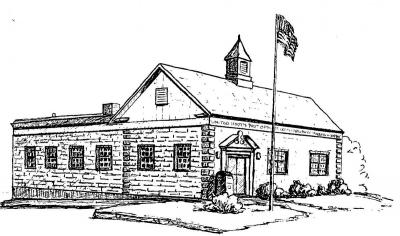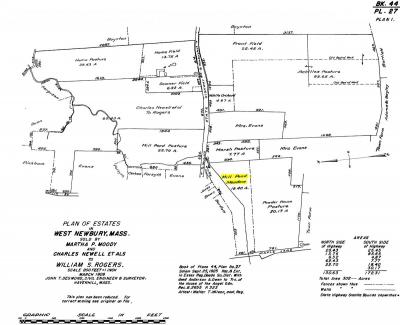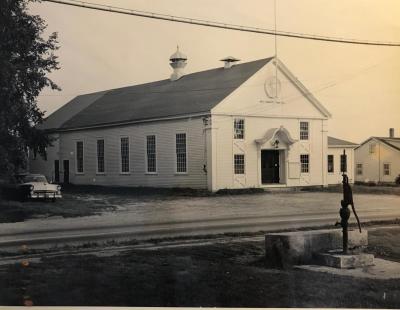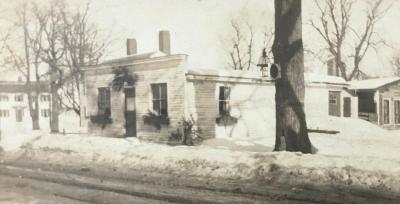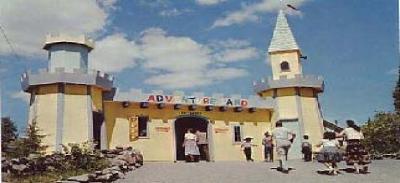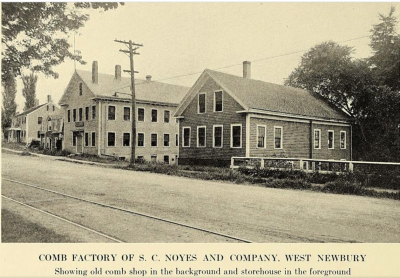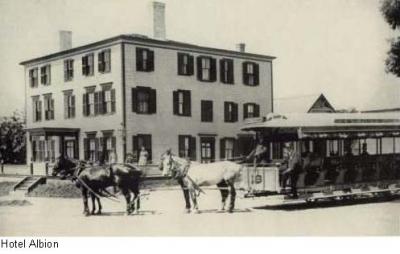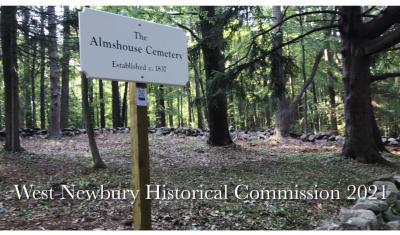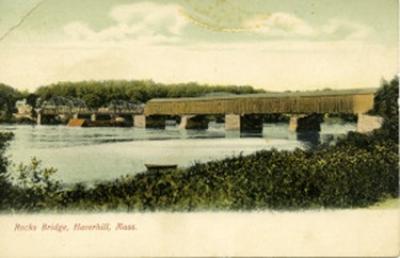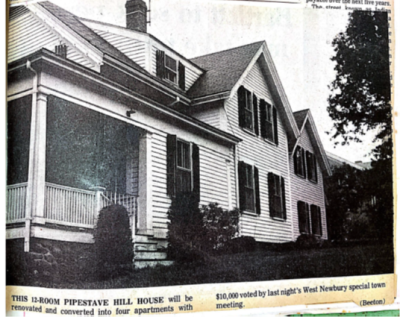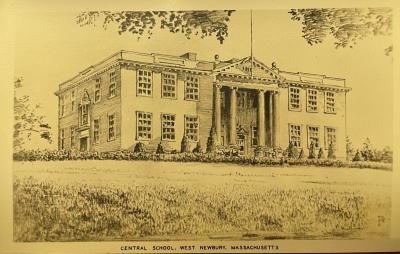A Historic Minute 2021–Notable Places
In 2021, the Historic Commission's monthly Minute Histories focused on notable places. Scroll down to find links to 12 stories below--
January 2021 This story concerns West Newbury’s Almshouse/Cemetery/Town Farm complex, tucked away at the corner of Poorhouse Lane and Archelaus Place, and now largely forgotten. From 1837 until it began withering away in the early 1900s, the complex was a major Town institution and a home of last resort for “inmates” with no place else to go. Few available Town records describe the Almshouse or its inmates (much less those buried in the Almshouse Cemetery), but census data unlock snapshots of the old, the sick, the poor, the disabled, the mentally ill, the orphaned, and others who spent time there.
February 2021 This story is about West Newbury's Post Office. August 22, 2020, marked the 200th birthday of West Newbury’s post office. For its first hundred years, the post office was housed in a store, whose proprietor “dispensed mail with groceries, together with a bit of local gossip or sage advice” and was paid a commission based on the value of stamps sold and canceled. In 1915, when the postmaster was a political appointee, infighting amongst local Democrats over the selection of West Newbury’s postmaster made headlines in the Boston Globe. Ordinarily, “[a]s the administration changed in Washington, so did the Post Office in West Newbury, from Bailey’s store to Cooney’s store next door …” at Post Office Square. These buildings were razed in the mid-1960s to make way for the post office in use now.
March 2021 This story features Mill Pond, which for much of its history, had neither a pond nor an associated mill. A mill and pond were present in the 1830’s-40’s, but disappeared by the 1850’s. In 1909 it was a channelized stream in a wet meadow, available for development. The Rogers family, which purchased the Pipestave Hill complex in that year as a summer estate and working farm, built the dam and created the pond as we know it in the 1910s. The Town began considering use of the pond in 1969, before its 1972 purchase of the Pipestave complex from Cardinal Cushing Academy. Since that time, West Newbury’s major investments in dam repairs and dredging have preserved this beautiful area for generations to come.
April 2021 This story concerns Town Hall, our oldest civic structure. The building has been well-loved, well-used, and at times abused since it first hosted Town Meeting on October 31, 1842. Stretched and pulled to meet new demands in the intervening years (fulfilling such roles as a basketball arena, an armory, a movie theater, and a jail) it has grown from 50 to 137 feet long. Always it has been left in care of the Selectmen with the expectation, as expressed in 1887, that they “exercise a fatherly care over their charge….”
May 2021 This month's tale features the Woman’s Clubhouse at the center of West Newbury. Over most of the 20th century the unassuming structure at 277 Main Street in Post Office Square was the “heart and home of the West Newbury Woman’s Club—and a meeting place for the community—for the Girl Scouts, Brownies, Foster Parents, Vacation Bible class, and garden clubs, to mention a few.” The building also functioned as nerve center for the Town’s well-being: the corps of women who owned the place went forth, determined to serve schoolchildren, shut-ins, the war effort, the environment, and more.
June 2021 This month’s tale concerns Adventure Land. For a handful of summers starting in 1957, West Newbury was home to cowboys, Indians, monkeys, and bears—not to mention the pirate ship, the railroad, and the big blue house-sized shoe. All were part of Adventure Land (“America’s Most Fabulous Family Entertainment”) which was located on Scotland Road across I-95, in the corner of West Newbury that now is home to the State Police barracks. Although heralded upon its opening as the next Disneyland, Adventure Land was on the market for sale or lease before the 1961 season and in foreclosure by 1965. Adventure Land lives in the memories of children who visited and young adults who worked there. And, thanks to Pentucket High School filmmakers, anyone can visit Adventure Land today, free of charge, just by clicking here.
Source: Combmaking in America
July 2021 This story concerns the repurposed shoe and comb factory buildings at 282 and 320-322 Main Street, which serve as reminders of West Newbury’s brief boom time as a manufacturing town of factory whistles, industrial stench, and labor disputes—along with remarkable wealth, growth, and civic improvement. Between the 1840s and the 1890s, West Newbury was an industrial town, with twice as many employed in manufacturing as farming. Yet in 1915, the Boston Globe described West Newbury, “‘beautiful for its situation’ on the banks of the Merrimac,” as having again “become a farming community entirely, with the exception of its being used as a ‘bedroom’ for many of the workers of Haverhill."
August 2021 This story features the Albion Hotel, now the site of the G.A.R. Library. A stately 3-story Federal-style mansion, the Albion building was West Newbury’s only structure to rival the grand homes on Newburyport’s High Street. In 1886, the horse-drawn trolley from Haverhill first arrived in Town, stopping at an adjacent car barn turnaround near the corner of Bailey’s Lane and Main Street. At the same time, the building became a hotel, on the way to its (in)famous place in Town history. The hotel lay not only at the end of the trolley line, but also in the cross hairs of a growing prohibitionist movement. During the final raid in 1915, attempts to destroy evidence failed as police deployed cans to catch beer pouring out the rainspout. The Emery Sisters bought the property and demolished the building, making way for the library some decades later.
September 2021 This story is about West Newbury’s Almshouse Cemetery, which the Town recognized and preserved in 2021. Consciously or not, almshouse graves, like the residents themselves, were perhaps designed to be forgotten. Historians explained, “The unworthy poor were institutionalized, kept literally at the margins of town society, and symbolically excluded at their death by burial in a pauper’s grave.” Construction excavators and, as in West Newbury, historians have led the way in rediscovering poorhouse graveyards, recognizing that those who died unclaimed should be remembered as part of the community. Click here for virtual gravestones for those in the Almshouse Cemetery, and click here for a video about the work of the DPW, Eagle Scout candidate Kade Dennis, and the Historical Commission to remember and preserve the burying place.
Source: Rocks Village Website
October 2021 This tale concerns Rocks Bridge (also known as the Rocks Village Bridge), a West Newbury icon, which has been more appreciated for its history and aesthetics than its functionality as a major thoroughfare. Main Street and its east/west parallels in Town formed the framework for transportation while, according to the Massachusetts Historical Commission, “[n]orth/south routes, striking out perpendicularly from the Merrimack, intersected these roads haphazardly, making travel in this direction difficult." Thus the bridge was “[n]ever an important route across the Merrimack….” It has been preserved as such to present day, notwithstanding consideration in the 1970s of making it part of a connector between I-95 and I-495. Of the 44 turntable movable span bridges in MassHighway’s database, Rocks Bridge is “the oldest of them all, … still operated by hand.” For a video of Captain Red’s stories about the bridge, click here.
November 2021 This tale concerns Town-sponsored affordable housing in West Newbury. Unlike the Almshouse and the Pipestave Hill apartments (which came with the Town’s purchase of the Cardinal Cushing Academy complex), additional Town-sponsored affordable housing now located at the municipal campus and Bachelor Street entailed a decades-long siege, punctuated by fierce battles upon identification of any specific site. A band of determined, dedicated, indefatigable volunteer members of the Council on Aging and the Housing Authority made it happen. It took 20 years from the time the need was first identified to the dedication of these new homes in 1992. In April of 1989, when success was near but still elusive, Housing Authority Chair Nancy Barry summarized the advocates’ unshakable determination to see it through: “We’ve come a long way, but there’s still a long way to go. …We want to continue until we reach a point where we have to take another tack.”
December 2021 This story is about the Central School (now known as the 1910 Building, or the Town Offices). West Newbury’s decision in 1909 to build a new Central School—the most consequential municipal building since Town Hall’s construction in 1842—was a testament to civic pride and investment in the future. It was also, like many school building projects, a reluctant acknowledgement that deplorable existing conditions made action unavoidable. Inevitably, intervening events made the building an imperfect solution to the Town’s educational needs, though always a commanding structure adaptable to new purposes


